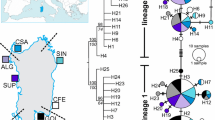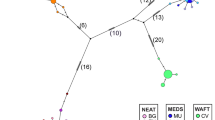Abstract
The genetic population structure of the highly migratory albacore (Thunnus alalunga) was investigated using restriction fragment length polymorphism (RFLP) analysis of the mitochondrial ATPase gene amplified by the polymerase chain reaction (PCR). 620 individuals comprising 13 geographically distant samples (ten Pacific, two Atlantic and the Cape of Good Hope) were surveyed between 1991 and 1994 with two restriction endonucleases (Mse I and Rsa I), resulting in seven haplotypes. No heterogeneity was observed in the distribution of haplotypes among the ten samples from the North and South Pacific, nor among the samples from North and South Atlantic and Cape of Good Hope. However, highly significant heterogeneity was evident among Atlantic and Pacific samples. Higher haplotypic diversity (h) was observed in the Pacific samples (0.59 to 0.69) than in the Atlantic and Cape samples (0.22 to 0.43). These results suggest greater gene flow between albacore of the northern and southern hemispheres (within oceans) than between the Atlantic and Pacific Oceans.
Similar content being viewed by others
References
Chow S, Clarke ME, Walsh PJ (1993) PCR-RFLP analysis on thirteen western Atlantic snappers (subfamily Lutjaninae): a simple method for species and stock identification. Fish Bull US 91: 619–627
Chow S, Inoue S (1993) Intra-and interspecific restriction fragment length polymorphisms in mitochondrial genes of Thunnus tuna species. Bull natn Res Inst Far Seas Fish 30: 207–225
Clemens HB (1961) The migration, age, and growth of Pacific albacore. Calif Dep Fish Game Fish Bull 115: 1–128
Collette BB, Nauen DA (1983) FAO species catalogue, Vol 2. Scombrids of the world: an annotated and illustrated catalogue of tunas, mackerels, bonitos and related species known to date. FAO Fish Synopsis 125: 1–137
Godsil HC (1948) A preliminary population study of the yellowfin and the albacore. Calif Dep Fish Game Fish Bull 70: 1–90
Graves JE, Dizon AE (1989) Mitochondrial DNA sequence similarity of Atlantic and Pacific albacore tuna (Thunnus alalunga). Can J Fish aquat Sciences 46: 870–873
Ishii T (1965) Morphometric analysis of the Atlantic albacore populations mainly her eastern areas. Bull Jap Soc scient Fish 31: 333–339 (in Japanese with English abstract)
Koto T (1968) Studies on the albacore-XIV. Distribution and movement of the albacore in the Indian and the Atlantic Oceans based on the catch statistics of Japanese tuna long-line fishery. Bull Far Seas Fish Res Lab, Japan 1: 115–129 (in Japanese with English abstract)
Kurogane K, Hiyama Y (1958) Morphometric comparison of the albacore from the northwest, the equatorial and the southwest Pacific. Rec oceanogr Wks in Japan 4: 67–75
Kurogane K, Hiyama Y (1959) Morphometric comparison of the albacore from the Indian and the Pacific Ocean. Rec oceanogr Wks in Japan 5: 68–84
Lewis AD (1990) South Pacific albacore stock structure: a review of available information. 3rd South Pacific Albacore Res Workshop, Working Paper No. 5. South Pacific Commission, Noumea, New Cadedonia, pp 1–13
Morita S (1977) On the relationship between the albacore stocks of the South Atlantic and Indian Oceans. ICCAT (Int Comm Conser Atl Tunas) SCRS/77/85: 232–237
Nakamura H (1969) Tuna distribution and migration. Fishing News Ltd, London
Otsu T (1960) Albacore migration and growth in the North Pacific as estimated from tag recoveries. Pacif Sci 14: 257–266
Otsu T, Uchida RN (1959) Sexual maturity of albacore in the Pacific Ocean. Fish Bull US 59: 787–305
Otsu T, Uchida RN (1962) Model of the migration of albacore in the North Pacific Ocean. Fish Bull US 63: 33–44
Nei M, Tajima F (1981) DNA polymorphism detectable by restriction endonucleases. Genetics 97: 145–163
Scoles DR, Graves JE (1993) Genetic analysis of the population structure of yellowfin tuna, Thunnus albacares, from the Pacific Ocean. Fish Bull US 91: 690–698
Sokal RR, Rohlf FJ (1981) Biometry, 2nd edn. W.H. Freeman and Company, New York
Suzuki A (1962) Serologocal studies of the races of tuna. VI. Bigeye-3 antigen occurred in the albacore. Rep Nankai Reg Fish Res Lab 16: 67–70 (in Japanese with English abstract)
Suzuki Z, Warashina Y, Kishida M (1977) The comparison of catches by regular and deep tuna longline gears in the western and central equatorial Pacific. Bull Far Seas Fish Res Lab, Japan 15: 51–89
Author information
Authors and Affiliations
Additional information
Communicated by T. Ikeda, Hiroshima
Rights and permissions
About this article
Cite this article
Chow, S., Ushiama, H. Global population structure of albacore (Thunnus alalunga) inferred by RFLP analysis of the mitochondrial ATPase gene. Marine Biology 123, 39–45 (1995). https://doi.org/10.1007/BF00350321
Received:
Accepted:
Issue Date:
DOI: https://doi.org/10.1007/BF00350321




